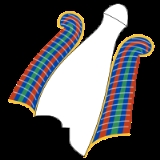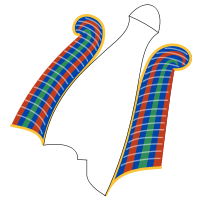
Atef
Encyclopedia

Osiris
Osiris is an Egyptian god, usually identified as the god of the afterlife, the underworld and the dead. He is classically depicted as a green-skinned man with a pharaoh's beard, partially mummy-wrapped at the legs, wearing a distinctive crown with two large ostrich feathers at either side, and...
. It combines the Hedjet
Hedjet
Hedjet is the formal name for the White Crown of pharaonic Upper Egypt. The crown was white and, after the unification of Egypt, it was combined with the Red Crown of Lower Egypt, with the delta to form the Pschent, the Double Crown of Egypt...
, the crown of Upper Egypt, with red ostrich feathers for the Osiris cult. The feathers are identified as ostrich from their curl or curve at the upper ends, with a slight flare toward the base. They are the same feather as (singly) worn by Maat
Maat
Maat is a naval rank of the German navy equivalent to the army rank of Unteroffizier. A Maat is considered the equivalent of a junior Petty Officer in the navies of many other nations....
. They may be compared with the falcon tail feathers in two-feather crowns
Shuti hieroglyph (two-feather adornment)
The ancient Egyptian Shuti, a two-feather adornment for crowns is part of a series of hieroglyphs for "crowns"; usage as a hieroglyph is not as common as the actual crown represented in Egyptian art, and artworks....
, such as those of Amun
Amun
Amun, reconstructed Egyptian Yamānu , was a god in Egyptian mythology who in the form of Amun-Ra became the focus of the most complex system of theology in Ancient Egypt...
which are more narrow and straight without curve.
The Atef crown identifies Osiris in ancient Egyptian painting. Osiris
Osiris
Osiris is an Egyptian god, usually identified as the god of the afterlife, the underworld and the dead. He is classically depicted as a green-skinned man with a pharaoh's beard, partially mummy-wrapped at the legs, wearing a distinctive crown with two large ostrich feathers at either side, and...
wears the Atef crown as a symbol of the ruler of the underworld
Underworld
The Underworld is a region which is thought to be under the surface of the earth in some religions and in mythologies. It could be a place where the souls of the recently departed go, and in some traditions it is identified with Hell or the realm of death...
. The tall bulbous white piece in the center of the crown is between two ostrich feathers. The feathers represent truth
Truth
Truth has a variety of meanings, such as the state of being in accord with fact or reality. It can also mean having fidelity to an original or to a standard or ideal. In a common usage, it also means constancy or sincerity in action or character...
, justice
Justice
Justice is a concept of moral rightness based on ethics, rationality, law, natural law, religion, or equity, along with the punishment of the breach of said ethics; justice is the act of being just and/or fair.-Concept of justice:...
, morality
Morality
Morality is the differentiation among intentions, decisions, and actions between those that are good and bad . A moral code is a system of morality and a moral is any one practice or teaching within a moral code...
, and balance
Balance (metaphysics)
In the metaphysical or conceptual sense, balance is used to mean a point between two opposite forces that is desirable over purely one state or the other, such as a balance between the metaphysical Law and Chaos — law by itself being overly controlling, chaos being overly unmanageable,...
. The Atef crown is similar, save for the feathers, to the plain white crown (Hedjet
Hedjet
Hedjet is the formal name for the White Crown of pharaonic Upper Egypt. The crown was white and, after the unification of Egypt, it was combined with the Red Crown of Lower Egypt, with the delta to form the Pschent, the Double Crown of Egypt...
) used in the Predynastic Period and later as a symbol for pharaonic
Pharaoh
Pharaoh is a title used in many modern discussions of the ancient Egyptian rulers of all periods. The title originates in the term "pr-aa" which means "great house" and describes the royal palace...
Upper Egypt
Upper Egypt
Upper Egypt is the strip of land, on both sides of the Nile valley, that extends from the cataract boundaries of modern-day Aswan north to the area between El-Ayait and Zawyet Dahshur . The northern section of Upper Egypt, between El-Ayait and Sohag is sometimes known as Middle Egypt...
.
See also
- Atef crown (hieroglyph)Atef crown (hieroglyph)The ancient Egyptian Atef crown hieroglyph is one of a series of language hieroglyphs related to Ancient Egyptian crowns, staves, dress, etc. Though used in the hieroglyphic language, the Atef crown is probably more commonly found in iconography, in tomb reliefs, wall scenes, statuary, or...
- Shuti hieroglyph (two-feather adornment)Shuti hieroglyph (two-feather adornment)The ancient Egyptian Shuti, a two-feather adornment for crowns is part of a series of hieroglyphs for "crowns"; usage as a hieroglyph is not as common as the actual crown represented in Egyptian art, and artworks....
- DeshretDeshretDeshret, from ancient Egyptian, was the formal name for the Red Crown of and for the desert Red Land on either side of Kemet, the fertile Nile river basin. The end has a curly wire on it, that represents the proboscis of a honey bee. Deshret or DSRT also represents the insect known as the honeybee...
- Red Crown of Lower Egypt - HedjetHedjetHedjet is the formal name for the White Crown of pharaonic Upper Egypt. The crown was white and, after the unification of Egypt, it was combined with the Red Crown of Lower Egypt, with the delta to form the Pschent, the Double Crown of Egypt...
- White Crown of Upper Egypt - PschentPschentThe Pschent was the name of the Double Crown of Ancient Egypt. The Ancient Egyptians generally referred to it as sekhemti , the Two Powerful Ones. It combined the Red Deshret Crown of Lower Egypt and the White Hedjet Crown of Upper Egypt....
- Double Crown of Lower & Upper Egypt - AtefAtefAtef is the specific feathered white crown of the Egyptian Deity Osiris. It combines the Hedjet, the crown of Upper Egypt, with red ostrich feathers for the Osiris cult. The feathers are identified as ostrich from their curl or curve at the upper ends, with a slight flare toward the base. They are...
- Hedjet Crown with feathers identified with OsirisOsirisOsiris is an Egyptian god, usually identified as the god of the afterlife, the underworld and the dead. He is classically depicted as a green-skinned man with a pharaoh's beard, partially mummy-wrapped at the legs, wearing a distinctive crown with two large ostrich feathers at either side, and... - KhepreshKhepreshThe Khepresh was an ancient Egyptian royal headdress. It is also known as the blue crown or war crown. New Kingdom pharaohs are often shown wearing it in battle, but it was also frequently worn in ceremonies...
- Blue or War Crown also called Royal Crown - UraeusUraeusThe Uraeus is the stylized, upright form of an Egyptian spitting cobra , used as a symbol of sovereignty, royalty, deity, and divine authority in ancient Egypt.The Uraeus is a symbol for the goddess Wadjet, who was one of the earliest Egyptian deities and who...
- Rearing Cobra
- N-red crown (n hieroglyph)N-red crown (n hieroglyph)The ancient Egyptian Red Crown, the Deshret crown, is one of the oldest Egyptian hieroglyphs. As an iconographic element, it is used on the famous Narmer Palette of Pharaoh Narmer as the "Red Crown of the Delta", the Delta being Lower Egypt....
- N-water ripple (n hieroglyph)N-water ripple (n hieroglyph)The ancient Egyptian ripple of water is one of the oldest language hieroglyphs from Ancient Egypt. It is used on a famous cartouche of Pharaoh Den of the First dynasty....

